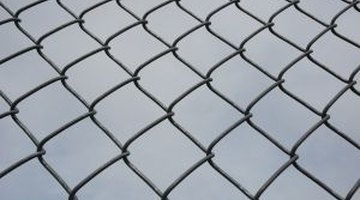Painting a Chain Link Fence
A common sight in many yards, chain link fences offer security for the homeowner and his pets. However, chain link fences are not stylish; they serve a utilitarian purpose only. If your chain link fence is an eyesore, you can paint it and spruce up the look of your yard.

In fact, painting a chain link fence might be easier than you think. With the correct tools and technique, you can paint your fence quickly with good results.
Things You Will Need
- Sandblaster (or wire brush)
- Rust inhibitor spray (or primer)
- Oil-based exterior gloss enamel paint
- Paint roller and handle
- Paint roller pan
- Paintbrush
- Masking tape
-
Give yourself and your fence, some space. Remove weeds, grass or plants beside the fence or use ropes to pull and tie them back while you work. Clear away soil from the bottom of the chain link and remove any fence ornaments before you start.
-
Begin by preparing the fence for painting. This involves removing rust and grimy buildup from an old fence. You can rent a sandblaster from a construction rental store and make quick work of blasting away grime and rust. Alternately, use a wire brush if there are only small areas that need attention.
-
Mask off areas you don’t want paint to get on. This includes garage walls or house walls that adjoin the fence as well as trees or other structures. Some homeowners want to paint only the chain link and not the supporting poles and frames. If this is your plan, use masking tape along the frames to prevent over-painting.
-
Spray rust inhibitor lightly on small areas where you removed existing rust or use a primer with rust inhibiting properties if you are treating a large area. You will apply primer in the same manner you will roll on the paint.
-
Choose a paint roller with a thick nap. Lambswool is a good choice because it stands up to long usage but it’s also pricey. A nap of at least 1-inch is essential for success.
-
Dip your roller into the paint pan and use the rim of the pan to remove excess paint. This is an important step because too much paint on your roller will result in runs.
-
Roll the roller vertically and then horizontally along the chain link, using only slight pressure to allow the deep nap to cover the inside portion of the links. If you notice paint pooling in the link creases, there is too much paint on your roller. Remove more on the pan before you continue.
-
Pay special attention to the linked areas of the fence and along the masked portions. Paint build-up in these places will crack later, creating an unsightly area where dirt can accumulate.
-
Take your time. Two or three thin coats of paint are better than one thick one.
The Drip Cap
- A common sight in many yards, chain link fences offer security for the homeowner and his pets.
- In fact, painting a chain link fence might be easier than you think.
- Give yourself and your fence, some space.
- This involves removing rust and grimy buildup from an old fence.
- Mask off areas you don’t want paint to get on.
- Spray rust inhibitor lightly on small areas where you removed existing rust or use a primer with rust inhibiting properties if you are treating a large area.
Writer Bio
Glenda Taylor is a contractor and a full-time writer specializing in construction writing. She also enjoys writing business and finance, food and drink and pet-related articles. Her education includes marketing and a bachelor's degree in journalism from the University of Kansas.
Photo Credits
- Photo, curtesy of Stock.xchng
- Photo, curtesy of Stock.xchng
More Articles



